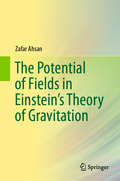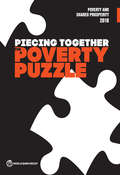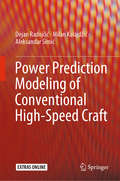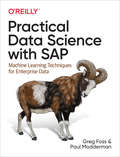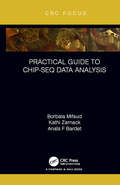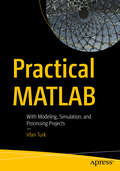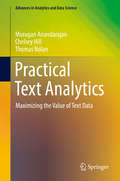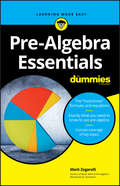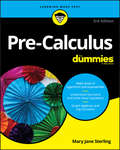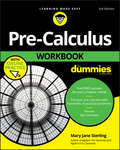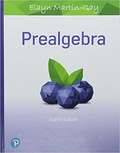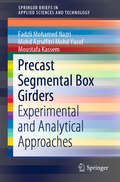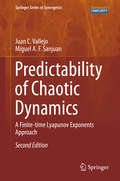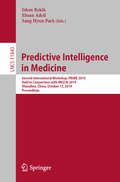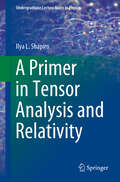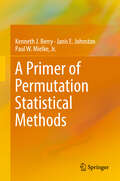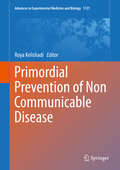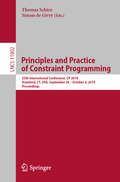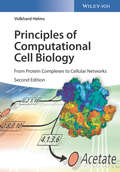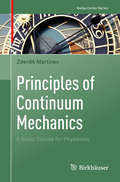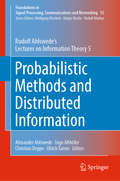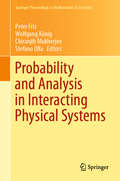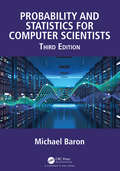- Table View
- List View
The Potential of Fields in Einstein's Theory of Gravitation
by Zafar AhsanThis book presents a detailed study of the Lanczos potential in general relativity by using tetrad formalisms. It demonstrates that these formalisms offer some simplifications over the tensorial methods, and investigates a general approach to finding the Lanczos potential for algebraic space–time by translating all the tensorial relations concerning the Lanczos potential into the language of tetrad formalisms and using the Newman–Penrose and Geroch–Held–Penrose formalisms. In addition, the book obtains the Lanczos potential for perfect fluid space–time, and applies the results to cosmological models of the universe. In closing, it highlights other methods, apart from tetrad formalisms, for finding the Lanczos potential, as well as further applications of the Newman–Penrose formalism. Given its scope, the book will be of interest to pure mathematicians, theoretical physicists and cosmologists, and will provide common ground for communication among these scientific communities.
Poverty and Shared Prosperity 2018: Piecing Together the Poverty Puzzle (Poverty and Shared Prosperity)
by World BankThe World Bank Group has two overarching goals: End extreme poverty by 2030 and promote shared prosperity by boosting the incomes of the bottom 40 percent of the population in each economy. As this year’s Poverty and Shared Prosperity report documents, the world continues to make progress toward these goals. In 2015, approximately one-tenth of the world’s population lived in extreme poverty, and the incomes of the bottom 40 percent rose in 77 percent of economies studied. But success cannot be taken for granted. Poverty remains high in Sub- Saharan Africa, as well as in fragile and conflict-affected states. At the same time, most of the world’s poor now live in middle-income countries, which tend to have higher national poverty lines. This year’s report tracks poverty comparisons at two higher poverty thresholds—$3.20 and $5.50 per day—which are typical of standards in lower- and upper-middle-income countries. In addition, the report introduces a societal poverty line based on each economy’s median income or consumption. Poverty and Shared Prosperity 2018: Piecing Together the Poverty Puzzle also recognizes that poverty is not only about income and consumption—and it introduces a multidimensional poverty measure that adds other factors, such as access to education, electricity, drinking water, and sanitation. It also explores how inequality within households could affect the global profile of the poor. All these additional pieces enrich our understanding of the poverty puzzle, bringing us closer to solving it. For more information, please visit worldbank.org/PSP
Power Prediction Modeling of Conventional High-Speed Craft
by Dejan Radojčić Milan Kalajdžić Aleksandar SimićThe proposed book addresses various power prediction methods, a principal design objective for high-speed craft of displacement, semi-displacement, and planing type. At the core of the power prediction methods are mathematical models based on experimental data derived from various high-speed hull and propeller series. Regression analysis and Artificial Neural Network (ANN) methods are used as extraction tools for this kind of models.The most significant factors for in-service power prediction are bare hull resistance, dynamic trim, and the propeller’s open-water efficiency. Therefore, mathematical modeling of these factors is a specific focus of the book. Furthermore, the book includes a summary of most of the power-prediction-relevant literature published in the last 50 years, and as such is intended as a reference overview of the best high-speed craft modeling practices.Once these mathematical models have been developed and validated, they can be readily programmed into software tools, thereby enabling the parametric analyses required for the optimization of a high-speed craft design. The proposed book is intended primarily for naval architects who design and develop various types of high-speed vessels (yachts, boats etc.), as well as for students who are interested in the design of fast vessels. The book includes useful Excel Macro Codes for the outlined mathematical models. Moreover, software for all considered models is provided.
Practical Data Science with SAP: Machine Learning Techniques for Enterprise Data
by Greg Foss Paul ModdermanLearn how to fuse today's data science tools and techniques with your SAP enterprise resource planning (ERP) system. With this practical guide, SAP veterans Greg Foss and Paul Modderman demonstrate how to use several data analysis tools to solve interesting problems with your SAP data.Data engineers and scientists will explore ways to add SAP data to their analysis processes, while SAP business analysts will learn practical methods for answering questions about the business. By focusing on grounded explanations of both SAP processes and data science tools, this book gives data scientists and business analysts powerful methods for discovering deep data truths.You'll explore:Examples of how data analysis can help you solve several SAP challengesNatural language processing for unlocking the secrets in textData science techniques for data clustering and segmentationMethods for detecting anomalies in your SAP dataData visualization techniques for making your data come to life
Practical Guide to ChIP-seq Data Analysis (Focus Computational Biology Series)
by Borbala Mifsud Kathi Zarnack Anaïs F BardetChromatin immunoprecipitation sequencing (ChIP-seq), which maps the genome-wide localization patterns of transcription factors and epigenetic marks, is among the most widely used methods in molecular biology. Practical Guide to ChIP-seq Data Analysis will guide readers through the steps of ChIP-seq analysis: from quality control, through peak calling, to downstream analyses. It will help experimental biologists to design their ChIP-seq experiments with the analysis in mind, and to perform the basic analysis steps themselves. It also aims to support bioinformaticians to understand how the data is generated, what the sources of biases are, and which methods are appropriate for different analyses.
Practical MATLAB: With Modeling, Simulation, and Processing Projects
by Irfan TurkApply MATLAB programming to the mathematical modeling of real-life problems from a wide range of topics. This pragmatic book shows you how to solve your programming problems, starting with a brief primer on MATLAB and the fundamentals of the MATLAB programming language. Then, you’ll build fully working examples and computational models found in the financial, engineering, and scientific sectors. As part of this section, you’ll cover signal and image processing, as well as GUIs. After reading and using Practical MATLAB and its accompanying source code, you’ll have the practical know-how and code to apply to your own MATLAB programming projects. What You Will LearnDiscover the fundamentals of MATLAB and how to get started with it for problem solvingApply MATLAB to a variety of problems and case studiesCarry out economic and financial modeling with MATLAB, including option pricing and compound interestUse MATLAB for simulation problems such as coin flips, dice rolling, random walks, and traffic flowsSolve computational biology problems with MATLABImplement signal processing with MATLAB, including currents, Fast Fourier Transforms (FFTs), and harmonic analysisProcess images with filters and edge detectionBuild applications with GUIs Who This Book Is ForPeople with some prior experience with programming and MATLAB.
Practical Text Analytics: Maximizing the Value of Text Data (Advances in Analytics and Data Science #2)
by Murugan Anandarajan Chelsey Hill Thomas NolanThis book introduces text analytics as a valuable method for deriving insights from text data. Unlike other text analytics publications, Practical Text Analytics: Maximizing the Value of Text Data makes technical concepts accessible to those without extensive experience in the field. Using text analytics, organizations can derive insights from content such as emails, documents, and social media. Practical Text Analytics is divided into five parts. The first part introduces text analytics, discusses the relationship with content analysis, and provides a general overview of text mining methodology. In the second part, the authors discuss the practice of text analytics, including data preparation and the overall planning process. The third part covers text analytics techniques such as cluster analysis, topic models, and machine learning. In the fourth part of the book, readers learn about techniques used to communicate insights from text analysis, including data storytelling. The final part of Practical Text Analytics offers examples of the application of software programs for text analytics, enabling readers to mine their own text data to uncover information.
Pre Algebra: A Student Workbook For Beginning Algebra
by Magic ClassroomThis workbook provides a complete review of Pre Algebra and Beginning Algebra.
Pre-Algebra Essentials For Dummies
by Mark ZegarelliPre-Algebra Essentials For Dummies (9781119590866) was previously published as Pre-Algebra Essentials For Dummies (9780470618387). While this version features a new Dummies cover and design, the content is the same as the prior release and should not be considered a new or updated product. Many students worry about starting algebra. Pre-Algebra Essentials For Dummies provides an overview of critical pre-algebra concepts to help new algebra students (and their parents) take the next step without fear. Free of ramp-up material, Pre-Algebra Essentials For Dummies contains content focused on key topics only. It provides discrete explanations of critical concepts taught in a typical pre-algebra course, from fractions, decimals, and percents to scientific notation and simple variable equations. This guide is also a perfect reference for parents who need to review critical pre-algebra concepts as they help students with homework assignments, as well as for adult learners headed back into the classroom who just need to a refresher of the core concepts. The Essentials For Dummies SeriesDummies is proud to present our new series, The Essentials For Dummies. Now students who are prepping for exams, preparing to study new material, or who just need a refresher can have a concise, easy-to-understand review guide that covers an entire course by concentrating solely on the most important concepts. From algebra and chemistry to grammar and Spanish, our expert authors focus on the skills students most need to succeed in a subject.
Pre-Calculus For Dummies: 1001 Practice Problems
by Elleyne Kase Yang KuangGet ahead in pre-calculus Pre-calculus courses have become increasingly popular with 35 percent of students in the U.S. taking the course in middle or high school. Often, completion of such a course is a prerequisite for calculus and other upper level mathematics courses. Pre-Calculus For Dummies is an invaluable resource for students enrolled in pre-calculus courses. By presenting the essential topics in a clear and concise manner, the book helps students improve their understanding of pre-calculus and become prepared for upper level math courses. Provides fundamental information in an approachable manner Includes fresh example problems Practical explanations mirror today’s teaching methods Offers relevant cultural references Whether used as a classroom aid or as a refresher in preparation for an introductory calculus course, this book is one you’ll want to have on hand to perform your very best.
Pre-Calculus Workbook For Dummies
by Mary Jane SterlingGet a handle on pre-calculus in a pinch! If you’re tackling pre-calculus and want to up your chances of doing your very best, this hands-on workbook is just what you need to grasp and retain the concepts that will help you succeed. Inside, you’ll get basic content review for every concept, paired with examples and plenty of practice problems, ample workspace, step-by-step solutions, and thorough explanations for each and every problem. In Pre-Calculus Workbook For Dummies, you’ll also get free access to a quiz for every chapter online! With all of the lessons and practice offered, you’ll memorize the most frequently used formulas, see how to avoid common mistakes, understand tricky trig proofs, and get the inside scoop on key concepts such as quadratic equations. Get ample review before jumping into a calculus course Supplement your classroom work with easy-to-follow guidance Make complex formulas and concepts more approachable Be prepared to further your mathematics studies Whether you’re enrolled in a pre-calculus class or you’re looking for a refresher as you prepare for a calculus course, this is the perfect study companion to make it easier.
Prealgebra
by Elayn Martin-GayElayn Martin-Gay is known for her accessible writing style with built-in study skills and support. <P><P> An emphasis on study skills is incorporated through the text. <P><P>In-text study skills resources include Section 1.1, Tips for Success in Mathematics, in which Elayn covers important strategies for success, with videos to motivate for each objective. <P><P>Additional in-text resources include the Student Resources section in the back of the text, which include Study Skill Builders, a Study Guide Outline, and Practice Final Exam. <P><P>Detailed step-by-step examples provide guidance for students, and practice margin exercises are paired with each example to actively involve students in the learning process. <P><P>Helpful Hints, strategically placed where students are most likely to need immediate reinforcement, help students avoid common trouble areas and mistakes. <P><P>All exercise sets have been carefully updated with this revision. Several special types of exercises throughout the text include Mixed Practice, Concept Extension, and more!
Precast Segmental Box Girders: Experimental and Analytical Approaches (SpringerBriefs in Applied Sciences and Technology)
by Fadzli Mohamed Nazri Mohd Azrulfitri Mohd Yusof Moustafa KassemThis book explores the fundamentals of the elastic behaviour of erected precast segmental box girders (SBG) when subjected to static load, as well as the construction process (casting and erection work) involved. It analyzes and compares the experimental results with those obtained using the finite element method and theoretical calculations. A short-term deflection analysis for different loads is obtained by determining the maximum deflection, stress and strain value of single span precast SBG under a variety of transversal slope. The outcome of this work provides a better understanding of the behaviour of precast SBG in terms of structural responses as well as defects, so that maintenance work can then be focused on the critical section at mid span area specifically for the bridge project longitudinally and transversely. The book is of interest to industry professionals involved in conducting static load tests on bridges, and all researchers, designers, and engineers seeking to validate experimental work with numerical and analytical approaches.
Predictability of Chaotic Dynamics: A Finite-time Lyapunov Exponents Approach (Springer Series in Synergetics)
by Juan C. Vallejo Miguel A. SanjuanThis book is primarily concerned with the computational aspects of predictability of dynamical systems - in particular those where observations, modeling and computation are strongly interdependent. Unlike with physical systems under control in laboratories, in astronomy it is uncommon to have the possibility of altering the key parameters of the studied objects. Therefore, the numerical simulations offer an essential tool for analysing these systems, and their reliability is of ever-increasing interest and importance. In this interdisciplinary scenario, the underlying physics provide the simulated models, nonlinear dynamics provides their chaoticity and instability properties, and the computer sciences provide the actual numerical implementation. This book introduces and explores precisely this link between the models and their predictability characterization based on concepts derived from the field of nonlinear dynamics, with a focus on the strong sensitivity to initial conditions and the use of Lyapunov exponents to characterize this sensitivity. This method is illustrated using several well-known continuous dynamical systems, such as the Contopoulos, Hénon-Heiles and Rössler systems. This second edition revises and significantly enlarges the material of the first edition by providing new entry points for discussing new predictability issues on a variety of areas such as machine decision-making, partial differential equations or the analysis of attractors and basins. Finally, the parts of the book devoted to the application of these ideas to astronomy have been greatly enlarged, by first presenting some basics aspects of predictability in astronomy and then by expanding these ideas to a detailed analysis of a galactic potential.
Predictive Intelligence in Medicine: Second International Workshop, PRIME 2019, Held in Conjunction with MICCAI 2019, Shenzhen, China, October 13, 2019, Proceedings (Lecture Notes in Computer Science #11843)
by Islem Rekik Ehsan Adeli Sang Hyun ParkThis book constitutes the proceedings of the Second International Workshop on Predictive Intelligence in Medicine, PRIME 2019, held in conjunction with MICCAI 2019, in Shenzhen, China, in October 2019. The 18 papers presented in this volume were carefully reviewed and selected for inclusion in this book. The contributions describe new cutting-edge predictive models and methods that solve challenging problems in the medical field for a high-precision predictive medicine.
A Primer in Tensor Analysis and Relativity (Undergraduate Lecture Notes in Physics)
by Ilya L. ShapiroThis undergraduate textbook provides a simple, concise introduction to tensor algebra and analysis, as well as special and general relativity. With a plethora of examples, explanations, and exercises, it forms a well-rounded didactic text that will be useful for any related course.The book is divided into three main parts, all based on lecture notes that have been refined for classroom teaching over the past two decades. Part I provides students with a comprehensive overview of tensors. Part II links the very introductory first part and the relatively advanced third part, demonstrating the important intermediate-level applications of tensor analysis. Part III contains an extended discussion of general relativity, and includes material useful for students interested primarily in quantum field theory and quantum gravity.Tailored to the undergraduate, this textbook offers explanations of technical material not easily found or detailed elsewhere, including an understandable description of Riemann normal coordinates and conformal transformations. Future theoretical and experimental physicists, as well as mathematicians, will thus find it a wonderful first read on the subject.
A Primer of Permutation Statistical Methods
by Kenneth J. Berry Janis E. Johnston Paul W. Mielke, Jr.The primary purpose of this textbook is to introduce the reader to a wide variety of elementary permutation statistical methods. Permutation methods are optimal for small data sets and non-random samples, and are free of distributional assumptions. The book follows the conventional structure of most introductory books on statistical methods, and features chapters on central tendency and variability, one-sample tests, two-sample tests, matched-pairs tests, one-way fully-randomized analysis of variance, one-way randomized-blocks analysis of variance, simple regression and correlation, and the analysis of contingency tables. In addition, it introduces and describes a comparatively new permutation-based, chance-corrected measure of effect size. Because permutation tests and measures are distribution-free, do not assume normality, and do not rely on squared deviations among sample values, they are currently being applied in a wide variety of disciplines. This book presents permutation alternatives to existing classical statistics, and is intended as a textbook for undergraduate statistics courses or graduate courses in the natural, social, and physical sciences, while assuming only an elementary grasp of statistics.
Primordial Prevention of Non Communicable Disease (Advances in Experimental Medicine and Biology #1121)
by Roya KelishadiThis volume provides a comprehensive overview on developmental origins of health and disease regarding various factors related to the origins of non-communicable diseases (NCDs) from early life. It offers a summary of the impacts of various factors such as epigenetics; gene-environment interaction; ethnic predisposition to NCDs and their risk factors; prenatal factors; fetal programming; maternal weight status and weight gain during pregnancy; type of feeding during infancy; growth pattern during childhood; obesity; stunting; socioeconomic status; dietary and physical activity habits; as well as environmental factors including air pollution and global climate change on the development and progress of NCDs.
Principles and Practice of Constraint Programming: 25th International Conference, CP 2019, Stamford, CT, USA, September 30 – October 4, 2019, Proceedings (Lecture Notes in Computer Science #11802)
by Thomas Schiex Simon De GivryThis book constitutes the proceedings of the 25th International Conference on Principles and Practice of Constraint Programming, CP 2019, held in Stamford, CT, USA, France, in September/October 2019.The 44 full papers presented in this volume were carefully reviewed and selected from 118 submissions. They deal with all aspects of computing with constraints including theory, algorithms, environments, languages, models, systems, and applications such as decision making, resource allocation, scheduling, configuration, and planning. The papers were organized according to the following topics/tracks: technical track; application track; multi-agent and parallel CP track; testing and verification track; CP and data science track; computational sustainability; and CP and life sciences track.
Principles of Computational Cell Biology: From Protein Complexes to Cellular Networks
by Volkhard HelmsComputational cell biology courses are increasingly obligatory for biology students around the world but of course also a must for mathematics and informatics students specializing in bioinformatics. This book, now in its second edition is geared towards both audiences. The author, Volkhard Helms, has, in addition to extensive teaching experience, a strong background in biology and informatics and knows exactly what the key points are in making the book accessible for students while still conveying in depth knowledge of the subject.About 50% of new content has been added for the new edition. Much more room is now given to statistical methods, and several new chapters address protein-DNA interactions, epigenetic modifications, and microRNAs.
Principles of Continuum Mechanics: A Basic Course for Physicists (Nečas Center Series)
by Zdeněk MartinecThis book addresses the basic concepts of continuum mechanics, that is, the classical field theory of deformable bodies. The theory is systematically developed, from the kinematics to the balance equations, the material theory, and the entropy principles. In turn, the linear-elastic solids, the ideal liquid and the Newtonian liquid are presented in detail as concrete applications. The book concludes by covering the theory of small motions in a medium with a finite prestress. In general, the emphasis is on presenting the content in a clear and straightforward way that requires only an elementary grasp of calculus, linear algebra, and Newtonian mechanics. The book is intended for students of physics, mechanics, engineering and the geosciences, as well as applied mathematics, with a year or more of college calculus behind them.
Probabilistic Methods and Distributed Information: Rudolf Ahlswede’s Lectures on Information Theory 5 (Foundations in Signal Processing, Communications and Networking #15)
by Rudolf Ahlswede Alexander Ahlswede Ingo Althöfer Christian Deppe Vladimir Blinovsky Ulrich Tamm Holger Boche Ulrich Krengel Ahmed MansourThe fifth volume of Rudolf Ahlswede’s lectures on Information Theory focuses on several problems that were at the heart of a lot of his research. One of the highlights of the entire lecture note series is surely Part I of this volume on arbitrarily varying channels (AVC), a subject in which Ahlswede was probably the world's leading expert. Appended to Part I is a survey by Holger Boche and Ahmed Mansour on recent results concerning AVC and arbitrarily varying wiretap channels (AVWC). After a short Part II on continuous data compression, Part III, the longest part of the book, is devoted to distributed information. This Part includes discussions on a variety of related topics; among them let us emphasize two which are famously associated with Ahlswede: "multiple descriptions", on which he produced some of the best research worldwide, and "network coding", which had Ahlswede among the authors of its pioneering paper. The final Part IV on "Statistical Inference under Communication constraints" is mainly based on Ahlswede’s joint paper with Imre Csiszar, which received the Best Paper Award of the IEEE Information Theory Society. The lectures presented in this work, which consists of 10 volumes, are suitable for graduate students in Mathematics, and also for those working in Theoretical Computer Science, Physics, and Electrical Engineering with a background in basic Mathematics. The lectures can be used either as the basis for courses or to supplement them in many ways. Ph.D. students will also find research problems, often with conjectures, that offer potential subjects for a thesis. More advanced researchers may find questions which form the basis of entire research programs.
Probability and Analysis in Interacting Physical Systems: In Honor of S.R.S. Varadhan, Berlin, August, 2016 (Springer Proceedings in Mathematics & Statistics #283)
by Peter Friz Wolfgang König Chiranjib Mukherjee Stefano OllaThis Festschrift on the occasion of the 75th birthday of S.R.S. Varadhan, one of the most influential researchers in probability of the last fifty years, grew out of a workshop held at the Technical University of Berlin, 15–19 August, 2016. This volume contains ten research articles authored by several of Varadhan's former PhD students or close collaborators. The topics of the contributions are more or less closely linked with some of Varadhan's deepest interests over the decades: large deviations, Markov processes, interacting particle systems, motions in random media and homogenization, reaction-diffusion equations, and directed last-passage percolation. The articles present original research on some of the most discussed current questions at the boundary between analysis and probability, with an impact on understanding phenomena in physics. This collection will be of great value to researchers with an interest in models of probability-based statistical mechanics.
Probability and Statistics for Computer Scientists, Third Edition
by Michael BaronPraise for the Second Edition: "The author has done his homework on the statistical tools needed for the particular challenges computer scientists encounter... [He] has taken great care to select examples that are interesting and practical for computer scientists. ... The content is illustrated with numerous figures, and concludes with appendices and an index. The book is erudite and … could work well as a required text for an advanced undergraduate or graduate course." ---Computing Reviews Probability and Statistics for Computer Scientists, Third Edition helps students understand fundamental concepts of Probability and Statistics, general methods of stochastic modeling, simulation, queuing, and statistical data analysis; make optimal decisions under uncertainty; model and evaluate computer systems; and prepare for advanced probability-based courses. Written in a lively style with simple language and now including R as well as MATLAB, this classroom-tested book can be used for one- or two-semester courses. Features: Axiomatic introduction of probability Expanded coverage of statistical inference and data analysis, including estimation and testing, Bayesian approach, multivariate regression, chi-square tests for independence and goodness of fit, nonparametric statistics, and bootstrap Numerous motivating examples and exercises including computer projects Fully annotated R codes in parallel to MATLAB Applications in computer science, software engineering, telecommunications, and related areas In-Depth yet Accessible Treatment of Computer Science-Related TopicsStarting with the fundamentals of probability, the text takes students through topics heavily featured in modern computer science, computer engineering, software engineering, and associated fields, such as computer simulations, Monte Carlo methods, stochastic processes, Markov chains, queuing theory, statistical inference, and regression. It also meets the requirements of the Accreditation Board for Engineering and Technology (ABET). About the Author Michael Baron is David Carroll Professor of Mathematics and Statistics at American University in Washington D. C. He conducts research in sequential analysis and optimal stopping, change-point detection, Bayesian inference, and applications of statistics in epidemiology, clinical trials, semiconductor manufacturing, and other fields. M. Baron is a Fellow of the American Statistical Association and a recipient of the Abraham Wald Prize for the best paper in Sequential Analysis and the Regents Outstanding Teaching Award. M. Baron holds a Ph.D. in statistics from the University of Maryland. In his turn, he supervised twelve doctoral students, mostly employed on academic and research positions.
